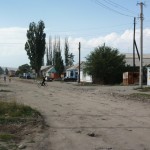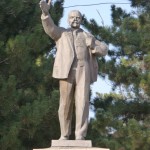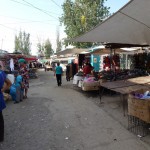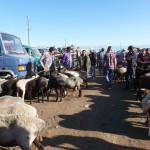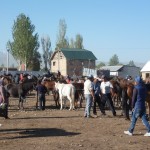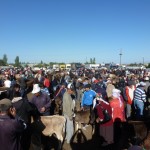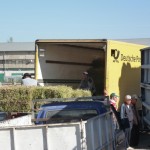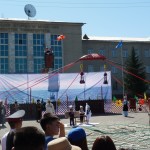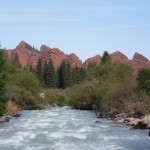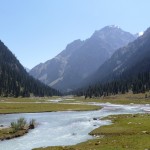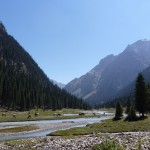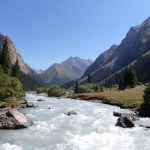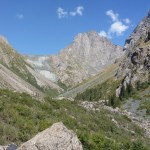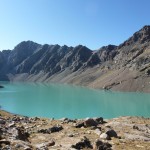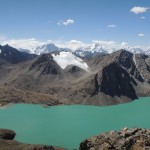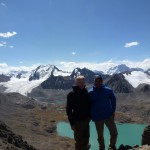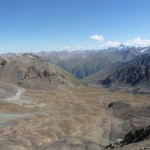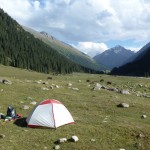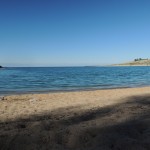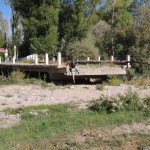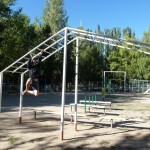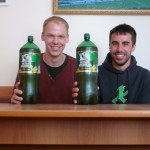Still being a bit overwhelmed and perhaps too confident about the easiness of taking a hitch in Central Asia, after the surprisingly uncomplicated border crossing to Kyrgyzstan, we jumped onto the passenger seats of an old pickup. The driver was also going all the way down along the Karkara River towards our first Kyrgyz destination, the 3rd biggest town Karakol. With our poor Russian we thought having agreed on a fair price, but when we reached our destination, the driver insisted that the price was meant to be in dollars and not the local currency. Of course this would have been way too much and the whole situation started becoming uncomfortable, almost threatening …. but in the end we could convince him to let us go without loosing such a big amount of money – yet with a slightly bitter feeling of having given him an inadequate wage for a journey he would have done anyway though. Additionally our backpacks smelled quite strongly like gasoline, because they had lied on old fuel drums in the van during the whole ride. All this was not the best start for our next country to visit! The city of Karakol itself was not really improving our mood, most houses, prefabricated blocks and streets are rather dilapidated or abandoned, there are no nice parks and everything seems to have been built thoughtless and without any soul. A few remaining buildings, monuments and avenues from the Soviet Era are always empty and contribute a lot to this bleak cityscape, and the few loveless and arbitrarily placed children’s attractions in the center are seldom used and totally unsuccessful in giving the town back a bit of life. Given that Karakol is famous for being a popular holiday destination, seeing this desolate state was a bit disappointing as well.
However, we actually had not planned to come here for the city itself, but especially for doing some trekking in the Central Tian Shan Mountains nearby. And luckily this turned out to be a very great idea. First of all, compared to Kazakhstan, more persons have at least a few notions of English (and even some broken German) which already makes communication considerably easier. Especially Taalai, owner of the highly recommendable Teskey Guesthouse, was super friendly and so helpful for giving the best tips, personal advices and explanations – without ever trying to sell something. The same holds for the tourist information (which is managed and hold by a youth-association of well-educated locals) and for the Ecotrek company, where we rented the necessary camping gear (tent, sleeping bag, gas stove and cooking equipment). We did a one-day trek to the beautiful Jeti-Öghüz Valley and hiked during three days from the Karakol Valley to the Arashan Valley, via the 3500m high lake Ala-Köl and a pass at nearly 4000m. Although the hiking itself was extremely exhausting (climbing over stone quarries, steep ascents to the passes, two freezingly cold nights under a tent, carrying camping gear and food for three days, whereas at least we could refill our bottles with water from natural sources all the time), we were rewarded with extraordinary views over the lake, torrents, icy glaciers and snow covered-mountains, so that every second of pain was totally worth it. Furthermore, considering that the week before there was even one meter of snow left, we were very lucky with the weather, never got wet because of rain but had the sun shining all the time. We can now understand better why quite a few trekking tourists (mainly from Europe and Russia) come to this region, and surprisingly many are travelling through whole Kyrgyzstan by bike. Even though the town still had nothing special to offer, we stayed one relaxing day more after our hike to take a rest. During that Sunday, we finally even discovered some more authentic and vivid places, which without being beautiful contrasted at least with the otherwise mainly soulless atmosphere. We were offered kymys, the Kyrgyz national drink, which is made of horse milk and tastes kind of special, having a strong sour and fermented flavor. We went to the animal market where horses, cows and many sheep are traded with, and we walked several times over the bazaars where we got a glance at the locals’ everyday life. Additionally, it was the 31st August, Kyrgyzstan’s National Independence Day. Usually there would be horse games organized at the hippodrome, but this year the government did not finance them so actually nothing took place. Therefore we assisted at the official ceremony at the main square instead, which was as unorganized as we are used to in the meantime. They built up the stage, the flags and the 10 VIP plastic chairs the same day, some children and adults with traditional Kyrgyz clothes held weird symbolic items, bad singers performed a dubious show, the national anthem was played, yellow and red balloons were released to the sky, and a few officials gave a speech. The people around did not seem to be really interested, it was yet another awkward situation so typical for Kyrgyzstan so far.
Finally our last stop in the Issyk Kul region was the village Tamga, located at the southern shore of the country’s biggest lake. We stayed one night at “Askar and Tamara’s Guesthouse“, whereas especially Tamara had incredibly many stories to tell: how she once took an Airbus plane to Seattle (“it was so big, they had 7 persons per row, everyone had his own TV, and they even had toilets, can you imagine that?”), experiences from the postwar period and Soviet occupation, problems with drunken Russians due to super cheap vodka, and so many anecdotes about the guests and nationalities she has hosted – everything told in a funny way. When he was young, her husband had participated at an exchange between socialist ruled countries with students from the German Democratic Republic and today he remembers a few phrases. We spent most of the day at the beach of the really clear and very blue Issyk Kul lake, which was not as cold as expected such that we even went swimming. On the way back to the village, we wandered through an old abandoned sanatorium, where apparently the Soviet elite or sports teams used to spend their vacations or training camps there and enjoyed the former luxurious facilities. It is a pity that such a nice and rare complex becomes less and less used and that the equipment gets more and more deteriorated, since while walking through the sanatorium, one could still feel and imagine the glorious holiday the “more equal” party officials may have spent there.
- memorable quotation: it’s very cheap – it’s Chinese
- to do: summit climb of Khan Tengri (apparently technically not too difficult except the height, and professional expeditions are organized by local companies) and of Lenin Peak in the Tajik Pamirs
